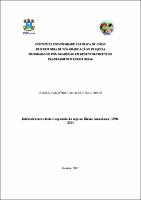| Compartilhamento |


|
Use este identificador para citar ou linkar para este item:
http://tede2.pucgoias.edu.br:8080/handle/tede/3872Registro completo de metadados
| Campo DC | Valor | Idioma |
|---|---|---|
| dc.creator | Oliveira Júnior, Itamar Antônio de | - |
| dc.creator.Lattes | http://lattes.cnpq.br/7306950462806606 | eng |
| dc.contributor.advisor1 | Silva, Margot Riemann Costa e | - |
| dc.contributor.advisor1Lattes | http://lattes.cnpq.br/0720255910463552 | eng |
| dc.contributor.referee1 | Pietrafesa, Pedro Araújo | - |
| dc.contributor.referee1Lattes | http://lattes.cnpq.br/4048337427692081 | eng |
| dc.contributor.referee2 | Rodrigues, Waldecy | - |
| dc.contributor.referee2Lattes | http://lattes.cnpq.br/4330949239387871 | eng |
| dc.date.accessioned | 2017-12-20T12:41:32Z | - |
| dc.date.issued | 2017-06-20 | - |
| dc.identifier.citation | Oliveira Júnior, Itamar Antônio de. Infraestrutura viária e expansão da soja no Bioma Amazônico, 1990- 2014. 2017. 77 f. Dissertação (Programa de Pós-Graduação STRICTO SENSU em Desenvolvimento e Planejamento Territorial) - Pontifícia Universidade Católica de Goiás, Goiânia-GO. | eng |
| dc.identifier.uri | http://tede2.pucgoias.edu.br:8080/handle/tede/3872 | - |
| dc.description.resumo | A expansão da soja no Brasil foi impulsionada na década de 70, principalmente com a migração dos produtores da região sul para o Brasil central, em especial o Estado de Mato Grosso e foi implementada na região por grandes grupos econômicos que contaram com o apoio do Estado. Neste processo - a princípio todo orientado para a exportação, portanto com insignificante lucro retido localmente - constatou-se o desmatamento de mata nativas, formação de grandes latifúndios e a coação à migração de pequenos produtores para os centros urbanos. Se por um lado as grandes tradings conseguem obter elevados lucros e por isso detém poder e influência sobre o governo, por outro têm-se situações de grave ameaça ao bioma que possui a maior biodiversidade do mundo e a maior bacia hidrográfica do planeta. Neste contexto, o presente trabalho de Mestrado em Desenvolvimento e Planejamento Territorial visa mostrar a aceleração do plantio da soja dentro do Bioma Amazônico entre os anos de 1990 a 2014 e os impactos causados pela expansão das fronteiras agrícolas. Para tanto fez-se necessário uma ampla pesquisa bibliográfica, análise estatística e um levantamento sobre a política de desenvolvimento regional envolvendo a soja no país, mostrando que essa política fora implantada por influência dos grandes grupos econômicos, tanto brasileiros quanto estrangeiros, sendo assim uma política excludente levando-se em conta as questões sociais e que acarretou em impactos ambientais negativos, como: a diminuição da biodiversidade na Amazônia, alteração drástica no índice de precipitação da Região e alteração das propriedades físico-químicas do solo. | eng |
| dc.description.abstract | The expansion of soybeans in Brazil was boosted in the 1970s, mainly due to the migration of the producers from the southern region to central Brazil, especially the State of Mato Grosso, and was implemented in the region by large economic groups that had the support of the Government. In this process - at first all created for export, therefore with insignificant profit retained on the spot - was verified the deforestation of native forests, the appearance of large latifundia and a coercion to the migration of small producers to the cities. In a way the big tradings can obtain high profits and therefore it has power and influence on the government, otherwise there are situations of serious threat to the biome that has the greater biodiversity of the world and also the greater hydrographic basin of the planet. In this context, the present work of Master in Development and Territorial Planning explains the acceleration of soybean planting in the Amazon Biome between 1990 and 2014 and the negative impacts caused by the expansion of agricultural frontiers. In order to do so, it was necessary to have a wide bibliographical research, statistical analysis and a survey on the regional development policy involving soybean in the country, showing that this policy was implemented by the influence of the great economic groups, both Brazilian and foreign, and thus a policy Exclusionary, taking into account the social issues and that resulted in negative environmental impacts, such as the reduction of biodiversity in the Amazon, drastic change in the precipitation index of the Region and alteration of the physical and chemical properties of the soil. | eng |
| dc.description.provenance | Submitted by admin tede ([email protected]) on 2017-12-20T12:41:32Z No. of bitstreams: 1 ITAMAR ANTÔNIO DE OLIVEIRA JÚNIOR.pdf: 1062489 bytes, checksum: eb8a97e5fd516c8e00e3829a7f176905 (MD5) | eng |
| dc.description.provenance | Made available in DSpace on 2017-12-20T12:41:32Z (GMT). No. of bitstreams: 1 ITAMAR ANTÔNIO DE OLIVEIRA JÚNIOR.pdf: 1062489 bytes, checksum: eb8a97e5fd516c8e00e3829a7f176905 (MD5) Previous issue date: 2017-06-20 | eng |
| dc.format | application/pdf | * |
| dc.thumbnail.url | http://tede2.pucgoias.edu.br:8080/retrieve/11909/ITAMAR%20ANT%c3%94NIO%20DE%20OLIVEIRA%20J%c3%9aNIOR.pdf.jpg | * |
| dc.language | por | eng |
| dc.publisher | Pontifícia Universidade Católica de Goiás | eng |
| dc.publisher.department | Escola de Gestão e Negócios::Curso de Ciências Econômicas | eng |
| dc.publisher.country | Brasil | eng |
| dc.publisher.initials | PUC Goiás | eng |
| dc.publisher.program | Programa de Pós-Graduação STRICTO SENSU em Desenvolvimento e Planejamento Territorial | eng |
| dc.rights | Acesso Aberto | |
| dc.subject | Amazônia. Soja. Impactos ambientais. Expansão das fronteiras agrícolas. | por |
| dc.subject | Amazon. Soy. Environmental impacts. Expansion of agricultural frontiers. | eng |
| dc.subject.cnpq | CIENCIAS SOCIAIS APLICADAS | eng |
| dc.title | Infraestrutura viária e expansão da soja no Bioma Amazônico, 1990- 2014 | eng |
| dc.type | Dissertação | eng |
| Aparece nas coleções: | Mestrado em Desenvolvimento e Planejamento Territorial | |
Arquivos associados a este item:
| Arquivo | Descrição | Tamanho | Formato | |
|---|---|---|---|---|
| ITAMAR ANTÔNIO DE OLIVEIRA JÚNIOR.pdf | Texto Completo | 1,04 MB | Adobe PDF |  Baixar/Abrir Pré-Visualizar |
Os itens no repositório estão protegidos por copyright, com todos os direitos reservados, salvo quando é indicado o contrário.




